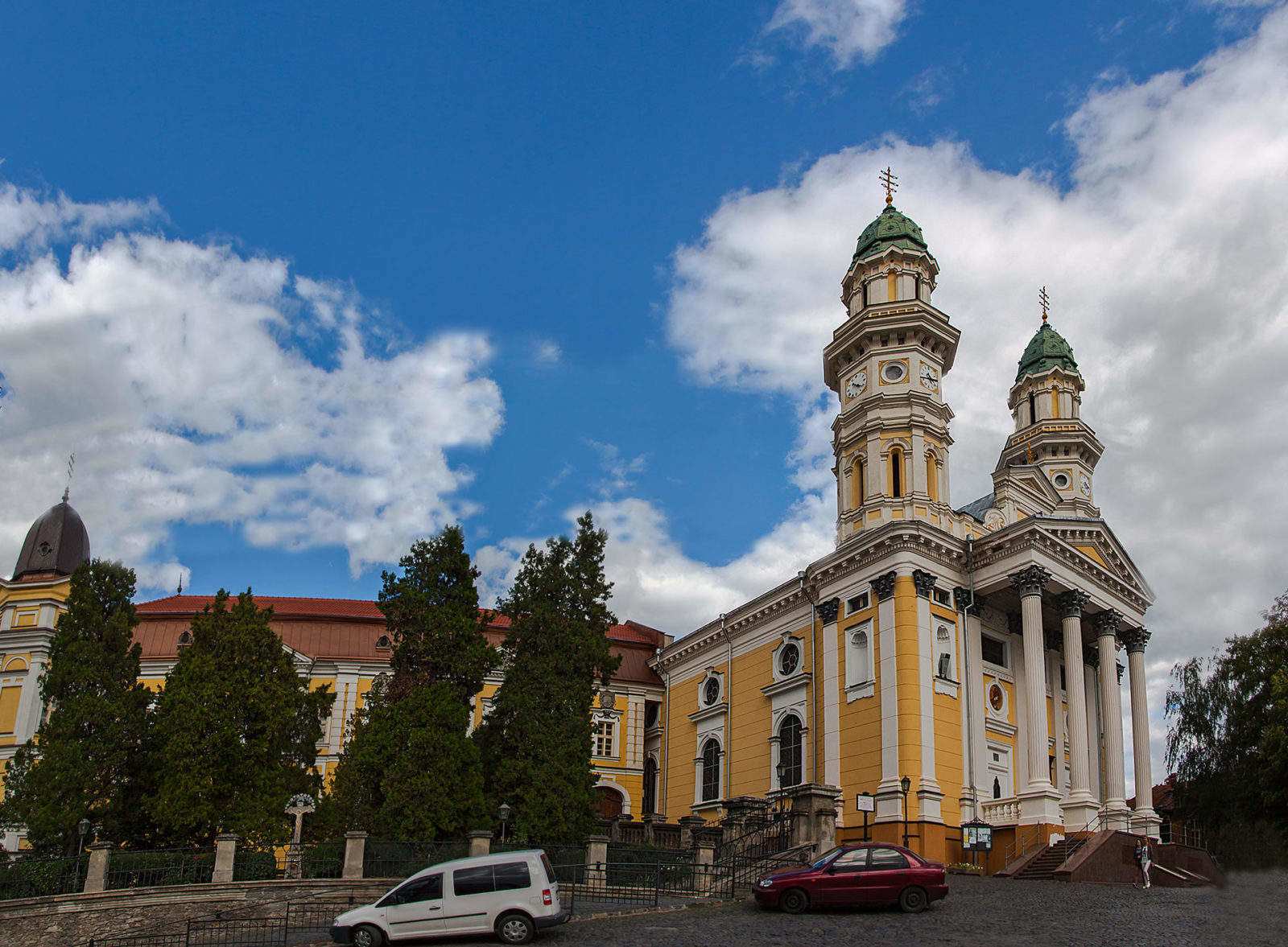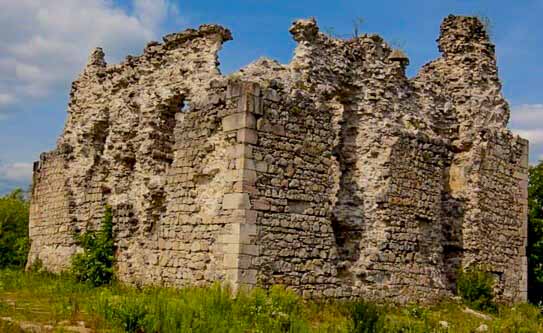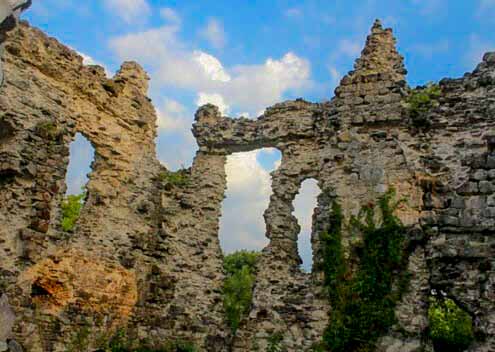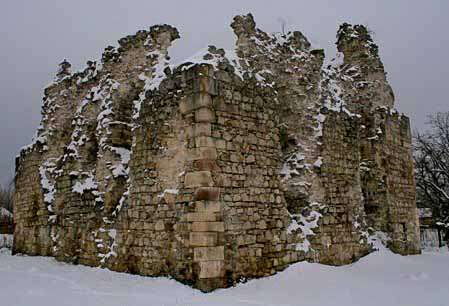Distance from Uzhgorod’s до Mukachevo – 42 kilometers, and in the middle between them is an urban – type settlement-Average.
This village was first mentioned in the XII century. The name arose precisely as a result of its location between the two main cities of Transcarpathia.

According to legend, the founders of the Middle city changed the location of their settlement several times, until it was exactly in the middle between the previous locations.
Sredne is famous for the remains of a 13th-century Templar castle. Serednyansky castle is considered the easternmost Outpost of this powerful medieval order and almost the only one the castle of the Silver land in the Romanesque style. The Templars, who were not only soldiers and monks, but also enterprising businessmen, were brought to Transcarpathia by the white gold of the middle ages – salt which is very rich in these lands. In addition to business, the Templars were engaged in providing medical care to the local population. They even knew how to perform surgical operations.

In 1312, the Templar order was liquidated, after which the fortress was transferred to the monks of St. Anthony, who also practiced medicine. Later, in 1380, the castle was taken over by the monks of the order of St. Paul, who were engaged in spreading Latin script and even opened a school. Later, during the reign of Charles Robert of Anjou, Serednyansky castle became a bone of contention between the king’s favorites, the magnates Druget and the feudal lords of Palochi. Feudal feud lasted for almost a hundred years before the Middle was finally taken over by representatives of the family of Palochi. After the death of the last representative of this family at the hands of an Ottoman warrior in the battle of Mogach in 1526, the castle came under the rule of the family of the Dobo. The most famous representative of this family was Istvan Dobo, who in 1552, during the Austro-Turkish war, led the heroic defense of Eger. During it, a small force of less than 2,000 soldiers held off the onslaught of Ali Pasha’s huge army, which numbered more than 100,000 soldiers, for more than a month. Istvan Dobo visited the Serednyansky castle many times. His son, with the help of the labor of the Turks who were captured, renewed and seriously strengthened the fortress.
In the XVII-XVIII centuries, the fortress became the scene of constant battles during permanent wars. The castle began to fall into disrepair. During the kuruz’s uprising at the beginning of the 18th century, the Serednyansky castle suffered serious destruction. It was never restored again.
To get to Serednyanskaya stronghold, you should go along the main street of the village, past the bus stop and a large temple we head to the mill, near which we turn into a small lane to the right. A few dozen meters further and to the right of the road you can see the gray ruins of the donjon tower, the only surviving fragment of the Serednyansky castle. The donjon is the main and most characteristic link of defense of any Romanesque fortress, its predecessors-the border Roman wooden towers of the Romans along the Rhine and Danube. The donjon of the Serednyansky castle was 20 meters high and consisted of three tiers. The walls of the castle were 2.6 meters thick.

The first two tiers of the tower have been preserved to this day, and the third one has been partially preserved. On the first tier were the Arsenal and the prison. Next to the donjon is a pit filled with stones. There is a version that it is the remains well. Also near the donjon you can see the remains of two lines of defense – a wooden palisade and a ring of moat with a rampart. There is a version that it was near this castle that the Templars hid their treasures. Someone knows perhaps in the future some lucky person would lucky to find them.
Video
Photo
#путешествиезакарпатьем #замкизакарпатья
Середнянский замок находится в селе Середне. До наших дней сохранился в руинах, никто не реставрирует и остатки замка продолжают исчезать. Мое посещение в 2014 году, возле замка игрались местные дети, практикуются в роли экскурсоводов, рядом местные высапают скот.
Середнянский замок состоит из одной четырёхугольной башни-донжона. Основан орденом тамплиеров в 12 веке. Они использовали замок как таможенный пост, а порой как место стояния небольших гарнизонов войска.
#закарпатье#кудапоехатьвзакарпатье#замкиукраины#середнє#среднее#середнянскийзамок#замоктамплиеров#руинызамка#замок#крепость#дворец#палац#мандруйзакарпаттям#мандруйукраїною#sunnyzak
Наша майская перезагрузка продолжилась в закарпатских замках. Турфирма “Butterfly-travel” (butterfly-travel.com.ua) организовала для нашей небольшой компании отдельный тур, благодаря которому мы посетили замки «Середнянский», «Паланок», «Сент-Миклош» и дворец Шенборнов. Наш экскурсовод Ирина (https://www.facebook.com/profile.php?id=100010413938859) очень увлекательно рассказывала исторические факты и захватывающие легенды, связанные с замками и их обладателями.
«Паланок» находится на въезде в Мукачево, это настоящее оборонное сооружение 17 века. Его хозяйка, прекрасная венгерская графиня Илона Зриньи, после смерти первого мужа 3 года держала оборону от австрийских захватчиков. За что стала единственной женщиной, которую наградил грамотой-атнаме султан османов Мехмед IV 👍👑
Еще одна занимательная легенда рассказывает, что основатель замка, чтобы построить колодец и добыть воду, заключил сделку с темными силами, пообещав 2 мешка золота 💰💰 Так как золота в казне не было, а сколько именно его должно быть в мешке не договаривались, пошли на хитрость. Предложили нечистому действительно мешки, но было в них всего по пару монет. Бронзовая скульптура князя-хитреца до сих пор красуется во дворе замка. У него можно попросить выполнить желание, подержав за указательный палец. Но желание нужно озвучивать максимально четко, иначе получите совсем не то, что ожидаете!
Замок Сент-Миклош 14 века – еще одна резиденция Илоны Зриньи. По легенде графиня тайно встречалась здесь со своим 2-м будущим мужем, борцом за свободу Венгрии. В одной из комнат замка, а именно в спальне графини, сейчас проводят церемонии бракосочетания молодоженов 💖💝
Дворец Шенборнов – это загородняя резиденция Софии, жены графа Шенборна, построенная в 19 в. Для любимой граф разбил возле дворца парк, где собрал хвойные деревья со всего мира, которые помогали врачевать болезнь жены. А она ему изменила. Любовник конечно поплатился жизнью, а чтобы посрамить изменщицу граф повесил в гостинной люстру в виде девушки с оленьими рогами и показывал ее всем заезжим гостям. Прямо мимишная месть 🙃😜
Продолжение⬇️
#revinaelenasensey #закарпатскиезамки #сентмиклош #паланок #дворецшенборнов #середнянскийзамок
#Середнянскийзамок, видится, не настолько интересным в плане живописности руин, как в том, что он является единственным замком тамплиеров на территории современной Украины. Поскольку в последнее время говорить о таинственном монашеском ордене тамплиеров стало модно, еще и куча книг о них написано и даже фильмы сняты, то и тут выплыла информация, что этот замок построили #тамплиеры в 12 в. И это была их самая восточная оборонительное точка на территории Европы. Поскольку #замок не служил никому резиденцией, а выполнял только оборонительные функции, то и размеров он был небольших: всего-навсего 18,6 на 16,5 метров. Сооружение имело вид трехярусной башни с толщиной стен до 2,6 метра и высотой около 20 метров. Кстати, именно такого вида замки в то время строились по всей Европе. Середнянский замок едва ли не единственный на всем #Закарпатье, который построен не на холме, а на равнине. Однако это совершенно не вредило его обороноспособности, поскольку он был окружен труднопроходимыми валами и рвами с водой. Остатки рвов можно лицезреть и сегодня - они превратились в болота вокруг #руины.
История рядом... Середнянский замок,12 век. Построено тамплиерами на Соляном пути как башня укрепление.#середнянскийзамок #тамплиеры
На каких фотография вы увидели человека? 😅
.
Прошу любить и жаловать, замок тамплиеров в Закарпатье, или Середнянский замок, а точнее руины замка, в поселке Середнее, которое находится недалеко от города Ужгород.
.
Сюда мы попали просто по пути, в планах посетить это место у нас не было, однако оно мне запомнилось! Здесь, каким-то образом ощущается романтика его каменного сердца, которое молчаливо хранит свою историю. (ну и потому что, продираясь, как всегда, через какие-то дебри, мы нашли вкусные груши, а ведь с обратной стороны была нормальная дорого. Ну нас же Google maps направил🤦) .
В таких местах меня разрывает ОГРОМНОЕ любопытство, как это место жило. Так и представляю, что вокруг все возводится на свое место и оживает.
.
Знаете в чем уникальность Середнянского замка.
Дюжина оборонных замков выросла в камне вдоль «соляного пути», но только Середнянский замок или замок тамплиеров сохранил романскую суровость архитектуры.
В отличие от наскальных братьев, замок тамплиеров расположился по центру долины. «Середина» ровной местности, какую не так просто отыскать в горах, что и дало название современному городку. Под ним почивает наследие неолита – первобытный человек облюбовал это выгодное место для стоянки. А целина вокруг источена кружевами подземных ходов. Работа пленных турок середины ХVI века - винные подвалы, до сих пор служит местному производству и туризму.
.
Современные тамплиеры утверждают, что где-то там должны были остаться сокровища, спасаемые в закарпатском донжоне от французского преследования. Но сегодня их напрасно высматривает в живописных руинах одинокий ветер.
.
.
.
.
.
.
.
#travelling #traveler #travel #travellingphotography #instatravel #instatraveller #travellerphotography #travellerlife #ukraine #nature #naturelove #naturestyle #freshair #love #lovefreshair #movement #instatravel #instatraveling #lovetravel #путешествие #маленькаяжизнь #украина #castle #palace
#сумбурногопутешествия #середнянскийзамок
#замоктамплиеров #тамплиеры #сумбурноепутешествие
Руины самого старого замока в Украине. Путешествие по зачарованным местам Закарпатья. 🏰
#середнянскийзамок #Ужгород #украина #замоктамплиеров
За мной замок Тамплиеров или Середнянский замок, а точнее то, что от него осталось. Возведен ещё в XII веке. Орден тамплиеров использовал замок в качестве таможенного поста. Местные гордятся такой достопримечательностью, а их дети👫 предлагают экскурсию по неприлично большой цене💰: бегут за тобой и уговаривают, что расскажут супер увлекательную историю замка. #закарпатье, #замокТамплиеров, #середне, #середнянскийзамок, #путешествие, #история, #руинызамка, #transkarpatia, #castle, #travel, #traveling, #mytrip, #iliketraveling
Уже вторую неделю не могу выздороветь после отпуска.
Поездка в Ужгород, работа и активный отпуск дали о себе знать. Все в бешеном ритме, не дня для лени и расслаблений. А я то после зимы еще не вошла в такой режим. 🏃🏃
В итоге приехала со слабостью и кашлем курящего 30 лет пирата. А впереди полностью загруженная неделя. 🙈
Но это было пол беды. Со среды страдаю на защимление нерва в верхней части спины. Все надеялась, что растирание поможет. Но с каждым рабочем днем и жуткой болью надежда испарялась.
Обидно еще то, что в телефоне или компьютере сидеть тоже больно, дольше 20 мин не могу. А у меня около 10гб отпускных фото. Как же все перебрать и выставить 😭
Чувствую себя старушкой. У меня такого комплекта еще никогда не было. Но ничего, я сильная, я справлюсь. 🙌🏼
.
📷 На фото разрушенный Середнянский замок. .
#середнянскийзамок
#замок #ужгород #руины #путешествия #travel #travelling #instsphoto #instatraveling #nature
Recent review













